Vladimir Ivanov
Research Center of the Artificial Intelligence Institute, Innopolis University, Russia
YABLoCo: Yet Another Benchmark for Long Context Code Generation
May 07, 2025Abstract:Large Language Models demonstrate the ability to solve various programming tasks, including code generation. Typically, the performance of LLMs is measured on benchmarks with small or medium-sized context windows of thousands of lines of code. At the same time, in real-world software projects, repositories can span up to millions of LoC. This paper closes this gap by contributing to the long context code generation benchmark (YABLoCo). The benchmark featured a test set of 215 functions selected from four large repositories with thousands of functions. The dataset contained metadata of functions, contexts of the functions with different levels of dependencies, docstrings, functions bodies, and call graphs for each repository. This paper presents three key aspects of the contribution. First, the benchmark aims at function body generation in large repositories in C and C++, two languages not covered by previous benchmarks. Second, the benchmark contains large repositories from 200K to 2,000K LoC. Third, we contribute a scalable evaluation pipeline for efficient computing of the target metrics and a tool for visual analysis of generated code. Overall, these three aspects allow for evaluating code generation in large repositories in C and C++.
Code Summarization Beyond Function Level
Feb 23, 2025Abstract:Code summarization is a critical task in natural language processing and software engineering, which aims to generate concise descriptions of source code. Recent advancements have improved the quality of these summaries, enhancing code readability and maintainability. However, the content of a repository or a class has not been considered in function code summarization. This study investigated the effectiveness of code summarization models beyond the function level, exploring the impact of class and repository contexts on the summary quality. The study involved revising benchmarks for evaluating models at class and repository levels, assessing baseline models, and evaluating LLMs with in-context learning to determine the enhancement of summary quality with additional context. The findings revealed that the fine-tuned state-of-the-art CodeT5+ base model excelled in code summarization, while incorporating few-shot learning and retrieved code chunks from RAG significantly enhanced the performance of LLMs in this task. Notably, the Deepseek Coder 1.3B and Starcoder2 15B models demonstrated substantial improvements in metrics such as BLEURT, METEOR, and BLEU-4 at both class and repository levels. Repository-level summarization exhibited promising potential but necessitates significant computational resources and gains from the inclusion of structured context. Lastly, we employed the recent SIDE code summarization metric in our evaluation. This study contributes to refining strategies for prompt engineering, few-shot learning, and RAG, addressing gaps in benchmarks for code summarization at various levels. Finally, we publish all study details, code, datasets, and results of evaluation in the GitHub repository available at https://github.com/kilimanj4r0/code-summarization-beyond-function-level.
Leveraging Large Language Models in Code Question Answering: Baselines and Issues
Nov 05, 2024Abstract:Question answering over source code provides software engineers and project managers with helpful information about the implemented features of a software product. This paper presents a work devoted to using large language models for question answering over source code in Python. The proposed method for implementing a source code question answering system involves fine-tuning a large language model on a unified dataset of questions and answers for Python code. To achieve the highest quality answers, we tested various models trained on datasets preprocessed in different ways: a dataset without grammar correction, a dataset with grammar correction, and a dataset augmented with the generated summaries. The model answers were also analyzed for errors manually. We report BLEU-4, BERTScore F1, BLEURT, and Exact Match metric values, along with the conclusions from the manual error analysis. The obtained experimental results highlight the current problems of the research area, such as poor quality of the public genuine question-answering datasets. In addition, the findings include the positive effect of the grammar correction of the training data on the testing metric values. The addressed findings and issues could be important for other researchers who attempt to improve the quality of source code question answering solutions. The training and evaluation code is publicly available at https://github.com/IU-AES-AI4Code/CodeQuestionAnswering.
The Llama 3 Herd of Models
Jul 31, 2024Abstract:Modern artificial intelligence (AI) systems are powered by foundation models. This paper presents a new set of foundation models, called Llama 3. It is a herd of language models that natively support multilinguality, coding, reasoning, and tool usage. Our largest model is a dense Transformer with 405B parameters and a context window of up to 128K tokens. This paper presents an extensive empirical evaluation of Llama 3. We find that Llama 3 delivers comparable quality to leading language models such as GPT-4 on a plethora of tasks. We publicly release Llama 3, including pre-trained and post-trained versions of the 405B parameter language model and our Llama Guard 3 model for input and output safety. The paper also presents the results of experiments in which we integrate image, video, and speech capabilities into Llama 3 via a compositional approach. We observe this approach performs competitively with the state-of-the-art on image, video, and speech recognition tasks. The resulting models are not yet being broadly released as they are still under development.
Sparse Concept Bottleneck Models: Gumbel Tricks in Contrastive Learning
Apr 04, 2024



Abstract:We propose a novel architecture and method of explainable classification with Concept Bottleneck Models (CBMs). While SOTA approaches to Image Classification task work as a black box, there is a growing demand for models that would provide interpreted results. Such a models often learn to predict the distribution over class labels using additional description of this target instances, called concepts. However, existing Bottleneck methods have a number of limitations: their accuracy is lower than that of a standard model and CBMs require an additional set of concepts to leverage. We provide a framework for creating Concept Bottleneck Model from pre-trained multi-modal encoder and new CLIP-like architectures. By introducing a new type of layers known as Concept Bottleneck Layers, we outline three methods for training them: with $\ell_1$-loss, contrastive loss and loss function based on Gumbel-Softmax distribution (Sparse-CBM), while final FC layer is still trained with Cross-Entropy. We show a significant increase in accuracy using sparse hidden layers in CLIP-based bottleneck models. Which means that sparse representation of concepts activation vector is meaningful in Concept Bottleneck Models. Moreover, with our Concept Matrix Search algorithm we can improve CLIP predictions on complex datasets without any additional training or fine-tuning. The code is available at: https://github.com/Andron00e/SparseCBM.
Cross-Modal Conceptualization in Bottleneck Models
Oct 23, 2023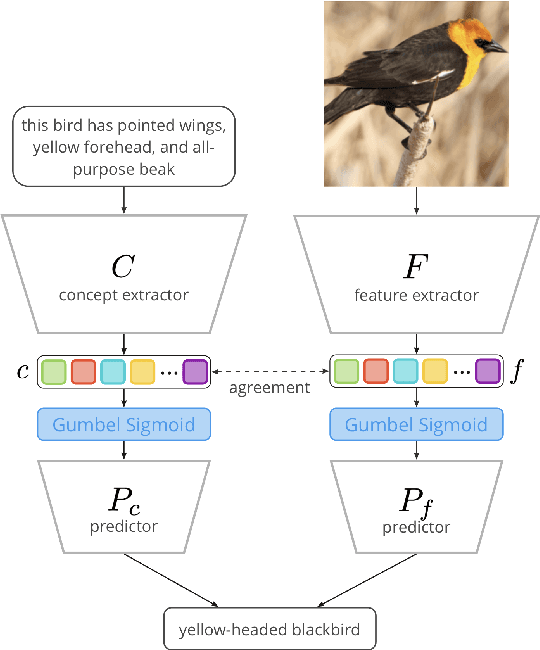
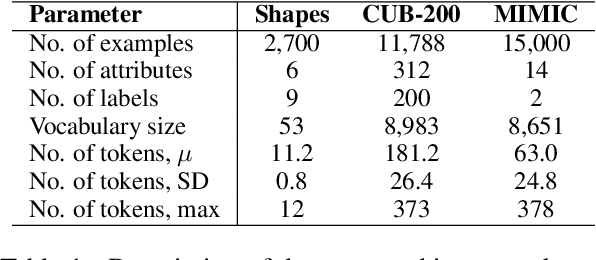
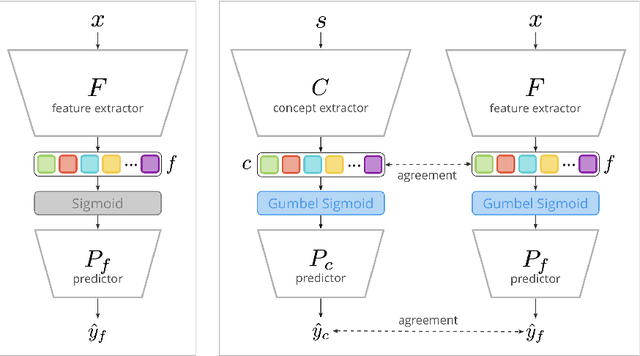

Abstract:Concept Bottleneck Models (CBMs) assume that training examples (e.g., x-ray images) are annotated with high-level concepts (e.g., types of abnormalities), and perform classification by first predicting the concepts, followed by predicting the label relying on these concepts. The main difficulty in using CBMs comes from having to choose concepts that are predictive of the label and then having to label training examples with these concepts. In our approach, we adopt a more moderate assumption and instead use text descriptions (e.g., radiology reports), accompanying the images in training, to guide the induction of concepts. Our cross-modal approach treats concepts as discrete latent variables and promotes concepts that (1) are predictive of the label, and (2) can be predicted reliably from both the image and text. Through experiments conducted on datasets ranging from synthetic datasets (e.g., synthetic images with generated descriptions) to realistic medical imaging datasets, we demonstrate that cross-modal learning encourages the induction of interpretable concepts while also facilitating disentanglement. Our results also suggest that this guidance leads to increased robustness by suppressing the reliance on shortcut features.
Automatic generation of a large dictionary with concreteness/abstractness ratings based on a small human dictionary
Jun 13, 2022



Abstract:Concrete/abstract words are used in a growing number of psychological and neurophysiological research. For a few languages, large dictionaries have been created manually. This is a very time-consuming and costly process. To generate large high-quality dictionaries of concrete/abstract words automatically one needs extrapolating the expert assessments obtained on smaller samples. The research question that arises is how small such samples should be to do a good enough extrapolation. In this paper, we present a method for automatic ranking concreteness of words and propose an approach to significantly decrease amount of expert assessment. The method has been evaluated on a large test set for English. The quality of the constructed dictionaries is comparable to the expert ones. The correlation between predicted and expert ratings is higher comparing to the state-of-the-art methods.
RuNNE-2022 Shared Task: Recognizing Nested Named Entities
May 23, 2022
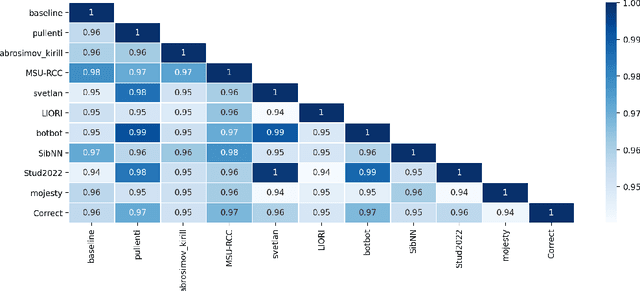
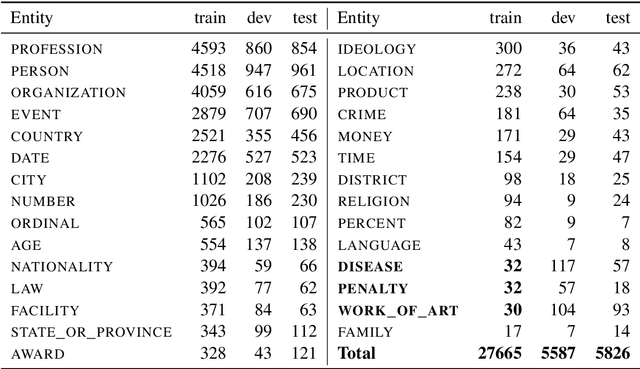

Abstract:The RuNNE Shared Task approaches the problem of nested named entity recognition. The annotation schema is designed in such a way, that an entity may partially overlap or even be nested into another entity. This way, the named entity "The Yermolova Theatre" of type "organization" houses another entity "Yermolova" of type "person". We adopt the Russian NEREL dataset for the RuNNE Shared Task. NEREL comprises news texts written in the Russian language and collected from the Wikinews portal. The annotation schema includes 29 entity types. The nestedness of named entities in NEREL reaches up to six levels. The RuNNE Shared Task explores two setups. (i) In the general setup all entities occur more or less with the same frequency. (ii) In the few-shot setup the majority of entity types occur often in the training set. However, some of the entity types are have lower frequency, being thus challenging to recognize. In the test set the frequency of all entity types is even. This paper reports on the results of the RuNNE Shared Task. Overall the shared task has received 156 submissions from nine teams. Half of the submissions outperform a straightforward BERT-based baseline in both setups. This paper overviews the shared task setup and discusses the submitted systems, discovering meaning insights for the problem of nested NER. The links to the evaluation platform and the data from the shared task are available in our github repository: https://github.com/dialogue-evaluation/RuNNE.
NEREL: A Russian Dataset with Nested Named Entities, Relations and Events
Sep 03, 2021
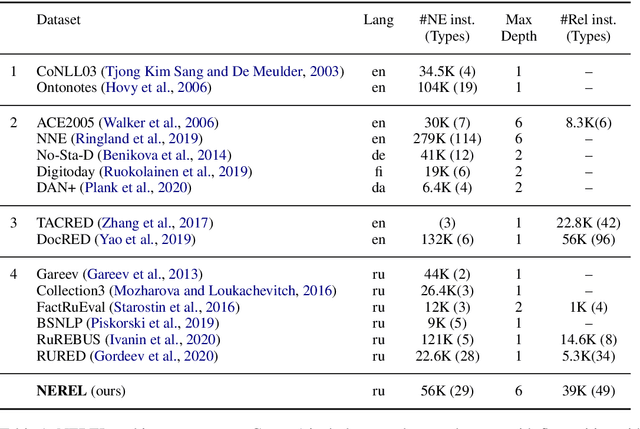
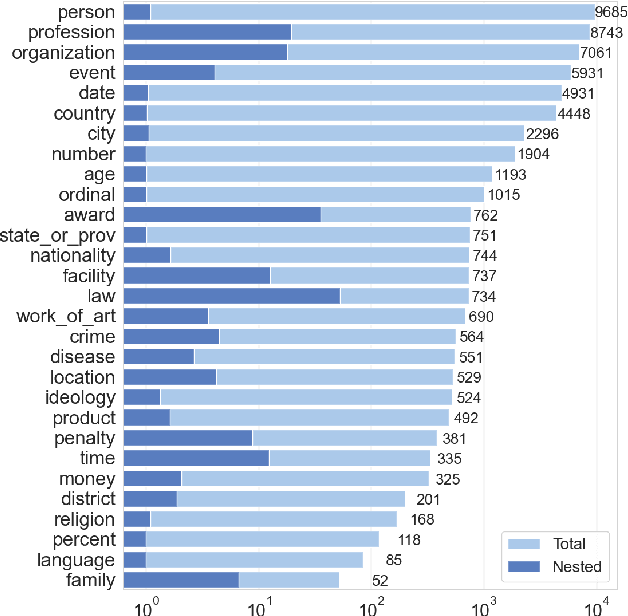
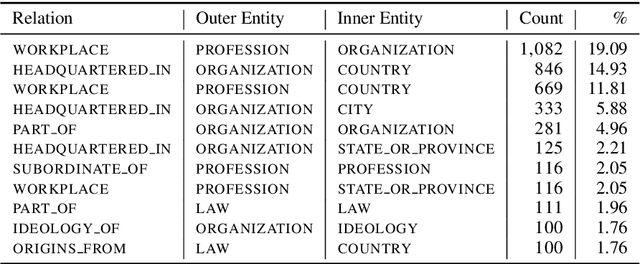
Abstract:In this paper, we present NEREL, a Russian dataset for named entity recognition and relation extraction. NEREL is significantly larger than existing Russian datasets: to date it contains 56K annotated named entities and 39K annotated relations. Its important difference from previous datasets is annotation of nested named entities, as well as relations within nested entities and at the discourse level. NEREL can facilitate development of novel models that can extract relations between nested named entities, as well as relations on both sentence and document levels. NEREL also contains the annotation of events involving named entities and their roles in the events. The NEREL collection is available via https://github.com/nerel-ds/NEREL.
RuREBus: a Case Study of Joint Named Entity Recognition and Relation Extraction from e-Government Domain
Oct 29, 2020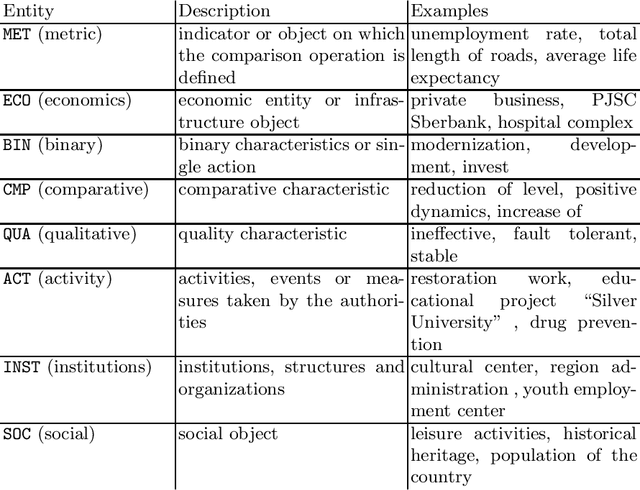

Abstract:We show-case an application of information extraction methods, such as named entity recognition (NER) and relation extraction (RE) to a novel corpus, consisting of documents, issued by a state agency. The main challenges of this corpus are: 1) the annotation scheme differs greatly from the one used for the general domain corpora, and 2) the documents are written in a language other than English. Unlike expectations, the state-of-the-art transformer-based models show modest performance for both tasks, either when approached sequentially, or in an end-to-end fashion. Our experiments have demonstrated that fine-tuning on a large unlabeled corpora does not automatically yield significant improvement and thus we may conclude that more sophisticated strategies of leveraging unlabelled texts are demanded. In this paper, we describe the whole developed pipeline, starting from text annotation, baseline development, and designing a shared task in hopes of improving the baseline. Eventually, we realize that the current NER and RE technologies are far from being mature and do not overcome so far challenges like ours.
 Add to Chrome
Add to Chrome Add to Firefox
Add to Firefox Add to Edge
Add to Edge